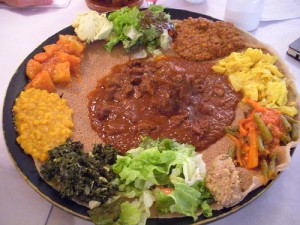The informant is a good friend from one of my clubs. We had met up for lunch and she shared many of her Ethiopian traditions and customs with me, as well as some superstitions of her people.
In Ethiopia, everyone at the dinner table eats the food from one dish, and no one has their own individual plate. The communal plate is very large, and an assortment of foods are served on it for everyone to share. Large pots of each type of food are made separately, and small portions are added to the communal plate at a time, since it’s not good to save leftovers that have been on the plate and touched. The saying is “it tastes like hands.” Therefore, leftovers are foods still in the pot that have yet to be touched, while the food on the communal plate is expected to be finished in that sitting.

The lesson is not overload the plate with food, since it can’t be eaten the next day because it will taste like the hands that touched it. Ethiopians eat their food with their hands instead of utensils, so the saying comes from this custom.
Background & Analysis
The informant is a student here at USC as well, and although her mother is from Ethiopia, she was born and raised here in California. However, she often goes back to Ethiopia with her mom to visit friends and family.
The meal serving tradition in Ethiopia is so different from what I’m used to here in America. We are accustomed to getting our own dish with a serving size of our own choice. Eating without utensils is also often seen as mannerless behavior, unless the food is something such as chicken or corn on the cob. The Ethiopian dinner style is similar to the traditional Hawaiian way of eating, especially the eating with your hands part. The foods are in their own bowls, and the bowls are passed around to everyone present, who each in turn take one bite and pass the food along to the next person. This will continue until everyone is full or the food is gone. The sharing of food in such intimate ways in both cultures, definitely brings people together.
